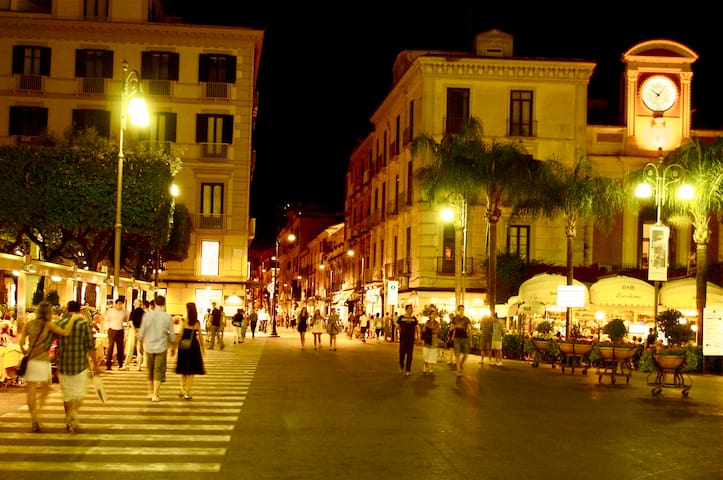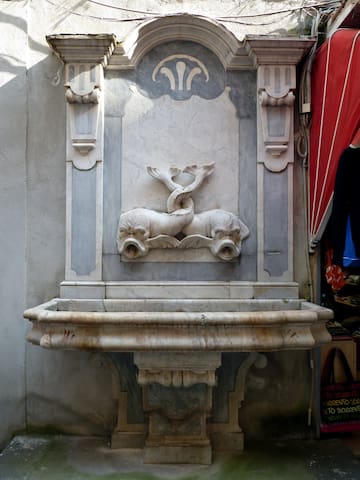Informazioni sulla città/località
The town of Sorrento is perched on a cliff overlooking the Neapolitan gulf and has a strategic position for the exploration of the nearby attractions and specialties. From Sorrento you can admire the isles of Capri, Ischia and Procida and the whole Gulf of Naples with its famous vulcano, the Vesuvius.
The fanciest and most expensive apartment and cafés are around Piazza Tasso which is also a joint between the old and the new town.
625 lokalkjente anbefaler
Sorrento
The town of Sorrento is perched on a cliff overlooking the Neapolitan gulf and has a strategic position for the exploration of the nearby attractions and specialties. From Sorrento you can admire the isles of Capri, Ischia and Procida and the whole Gulf of Naples with its famous vulcano, the Vesuvius.
The fanciest and most expensive apartment and cafés are around Piazza Tasso which is also a joint between the old and the new town.
Self-guided Sorrento Walking Tour
The center of Sorrento, close to the traffic, is easy to explore on foot. Here is a self-guided Sorrento tour itinerary which includes the most interesting sights in town and can be completed in just a few hours.
The most obvious place to begin your walk is Sorrento's main piazza, named for the Italian poet Torquato Tasso who was born in this coastal town. In one corner of the piazza, behind the stand where horse-drawn carriages pick up passengers, there is a statue dedicated to this famous native. In the center of the piazza, instead, you can see the statue of Sorrento's patron saint, Saint Antonino...the city celebrates his feast day each year on February 14th.
Piazza Tasso isn't a particularly historic square...it dates back only about a century. It was built above the gorge which was once home to a number of mills. In the 1800's, instead of cafés and shops, you would have seen local women hand-washing their laundry in the stream which ran from the hills behind down to the sea below. If you look down from the Piazza, you can still see the gorge known as the Valley of the Mills and, at the bottom, a number of abandoned mills which were powered by the force of the rushing water; unfortunately, the mills are closed to visitors.
Piazza Torquato Tasso
Piazza Torquato TassoThe most obvious place to begin your walk is Sorrento's main piazza, named for the Italian poet Torquato Tasso who was born in this coastal town. In one corner of the piazza, behind the stand where horse-drawn carriages pick up passengers, there is a statue dedicated to this famous native. In the center of the piazza, instead, you can see the statue of Sorrento's patron saint, Saint Antonino...the city celebrates his feast day each year on February 14th.
Piazza Tasso isn't a particularly historic square...it dates back only about a century. It was built above the gorge which was once home to a number of mills. In the 1800's, instead of cafés and shops, you would have seen local women hand-washing their laundry in the stream which ran from the hills behind down to the sea below. If you look down from the Piazza, you can still see the gorge known as the Valley of the Mills and, at the bottom, a number of abandoned mills which were powered by the force of the rushing water; unfortunately, the mills are closed to visitors.
Instead of taking Corso Italia from Piazza Tasso, pass behind the statue of Torquato Tasso and walk down Via della Pietà. This road is part of the old town of Sorrento, which was laid out in a grid pattern. There are a number of examples of Medieval architecture which still stand along this road, including Palazzo Correale and the Church of Santa Maria della Pietà next door; further along you can also see Palazzo Veniero and the porticoes of Vico Galantario.
Via Santa Maria della Pietà
Via Santa Maria della PietàInstead of taking Corso Italia from Piazza Tasso, pass behind the statue of Torquato Tasso and walk down Via della Pietà. This road is part of the old town of Sorrento, which was laid out in a grid pattern. There are a number of examples of Medieval architecture which still stand along this road, including Palazzo Correale and the Church of Santa Maria della Pietà next door; further along you can also see Palazzo Veniero and the porticoes of Vico Galantario.
At the end of Via della Pietà, you'll find yourself in front of Sorrento's Cathedral, a Baroque-style building where an antique Nativity scene from the 1700's is on permanent display. Continue your walk down Corso Italia, lined with fashionable shops and boutiques. Along the way, you'll pass Villa Fiorentino, headquarters of the Sorrento Foundation where exhibitions are often held. Over the past few years, shows of works by Dalì, Picasso, and the Italian sculptor Pomodoro have been held here.
Corso Italia
Corso ItaliaAt the end of Via della Pietà, you'll find yourself in front of Sorrento's Cathedral, a Baroque-style building where an antique Nativity scene from the 1700's is on permanent display. Continue your walk down Corso Italia, lined with fashionable shops and boutiques. Along the way, you'll pass Villa Fiorentino, headquarters of the Sorrento Foundation where exhibitions are often held. Over the past few years, shows of works by Dalì, Picasso, and the Italian sculptor Pomodoro have been held here.
The Lanes of the Historic Center
Once you have walked the length of Corso Italia, turn right and then right again on Via San Cesareo, one of the most charming historic streets in Sorrento and lined with artisan workshops. Along this street, you'll pass Sedil Dominova, easy to spot with its imposing frescoed cupola. This was once a social club where the high society of Sorrento would meet, and is now the headquarters of the Società di Mutuo Soccorso. Each Christmas, a traditional Neapolitan Nativity scene is on display here.
Take Via Reginaldo Giuliani down to the Villa Comunale.
28 lokalkjente anbefaler
Via San Cesareo
Via San CesareoThe Lanes of the Historic Center
Once you have walked the length of Corso Italia, turn right and then right again on Via San Cesareo, one of the most charming historic streets in Sorrento and lined with artisan workshops. Along this street, you'll pass Sedil Dominova, easy to spot with its imposing frescoed cupola. This was once a social club where the high society of Sorrento would meet, and is now the headquarters of the Società di Mutuo Soccorso. Each Christmas, a traditional Neapolitan Nativity scene is on display here.
Take Via Reginaldo Giuliani down to the Villa Comunale.
La Villa and the Cloister of San Francesco
Sorrento's Villa Comunale is a large terrace overlooking the Gulf; directly below the tufa cliff you can see the beach clubs in Marina Piccola and the port beyond. The elevator taking passengers down to Sorrento's port departs from here. There is a small Medieval cloister dating from the 1300's next to the Villa Comunale, often used for weddings. Upstairs, there are often art and photography exhibits.
From here, you can either return to Piazza Tasso passing through Piazza Sant'Antonino, or continue your walk to Marina Grande.
67 lokalkjente anbefaler
Villa Comunale
Via San FrancescoLa Villa and the Cloister of San Francesco
Sorrento's Villa Comunale is a large terrace overlooking the Gulf; directly below the tufa cliff you can see the beach clubs in Marina Piccola and the port beyond. The elevator taking passengers down to Sorrento's port departs from here. There is a small Medieval cloister dating from the 1300's next to the Villa Comunale, often used for weddings. Upstairs, there are often art and photography exhibits.
From here, you can either return to Piazza Tasso passing through Piazza Sant'Antonino, or continue your walk to Marina Grande.
The Museo della Tarsia Lignea (Inlaid Wood Museum)
You will probably have noticed the breathtaking inlaid wood panels decorating Sorrento's Cathedral. To get a better idea of the history and importance of this local craft, visit the local museum of inlaid wood. The collection includes pieces of furniture crafted over the last century, and a wing dedicated to contemporary pieces of modern design.
28 lokalkjente anbefaler
Museum Shop of Wood Inlay
28 Via S. NicolaThe Museo della Tarsia Lignea (Inlaid Wood Museum)
You will probably have noticed the breathtaking inlaid wood panels decorating Sorrento's Cathedral. To get a better idea of the history and importance of this local craft, visit the local museum of inlaid wood. The collection includes pieces of furniture crafted over the last century, and a wing dedicated to contemporary pieces of modern design.
Enter the heart of Sorrento to discover a place rich in history, the guardian of an invaluable heritage. The summer residence of the Correale family and its wonderful garden “Villa alla Rota” open the doors to lovers of beauty and refinement to offer a real journey through the centuries today: from archaeological finds to Sorrento marquetry, from the Neapolitan Mannerism school of art of the 1500s to the paintings of the Neapolitan artists of the “School of Posillipo”, from the invaluable historic furnishings to the prestigious porcelain of the 1700s
153 lokalkjente anbefaler
Correale Museum
50 Via CorrealeEnter the heart of Sorrento to discover a place rich in history, the guardian of an invaluable heritage. The summer residence of the Correale family and its wonderful garden “Villa alla Rota” open the doors to lovers of beauty and refinement to offer a real journey through the centuries today: from archaeological finds to Sorrento marquetry, from the Neapolitan Mannerism school of art of the 1500s to the paintings of the Neapolitan artists of the “School of Posillipo”, from the invaluable historic furnishings to the prestigious porcelain of the 1700s






